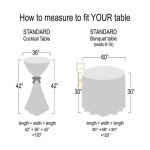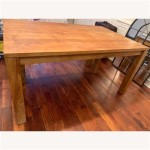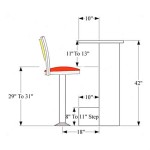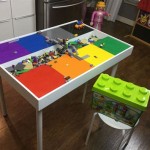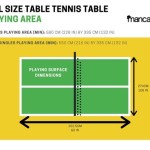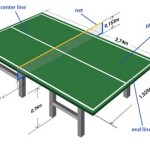Wood and Steel Tables: A Fusion of Strength and Style
Wood and steel tables represent a popular furniture choice, blending the natural warmth and visual appeal of wood with the industrial strength and modern aesthetic of steel. This combination offers versatility, durability, and a unique design statement suitable for a wide range of environments from residential dining rooms and living spaces to commercial offices, restaurants, and retail establishments. The inherent contrast between the materials allows for creative expression, making these tables a focal point in any setting.
The construction of wood and steel tables typically involves a wooden tabletop, which can be crafted from various types of wood, resting upon a steel base or legs. The choice of wood species and steel finishing significantly impacts the overall style and character of the table. For example, reclaimed wood paired with powder-coated steel creates a rustic-industrial vibe, while a polished hardwood surface on sleek, stainless steel legs offers a more contemporary and refined appearance.
The use of wood and steel offers a significant advantage in terms of structural integrity. Steel, known for its high tensile strength, provides a robust and stable base capable of supporting substantial weight. Wood, while generally lighter than steel, contributes to the table's overall aesthetic and provides a tactile surface that is often preferred over the cold, hard feel of metal alone. The combination creates a piece of furniture that is both visually appealing and built to last.
The Advantages of Wood and Steel Construction
One of the primary advantages of wood and steel tables lies in their durability. Steel, properly treated to prevent rust and corrosion, offers exceptional longevity. Powder coating, a common finishing technique for steel furniture, creates a resilient protective layer that resists scratches, chips, and fading. This makes steel components ideal for high-traffic areas where furniture is subjected to daily wear and tear.
Similarly, the durability of the wooden tabletop depends on the type of wood used and the quality of its finish. Hardwoods like oak, maple, and walnut are known for their resistance to dents and scratches, making them popular choices for tabletops. Applying a protective finish, such as varnish, lacquer, or polyurethane, further enhances the wood's durability by providing a barrier against moisture, stains, and UV damage. Regular maintenance, including cleaning and occasional refinishing, can extend the life of the wooden tabletop for many years.
Beyond durability, wood and steel tables offer a significant degree of design flexibility. The combination of materials allows for a wide range of styles, from minimalist and modern to rustic and industrial. Steel can be shaped into various forms, from simple straight legs to intricate geometric designs, while wood can be stained, painted, or left natural to achieve the desired aesthetic. This versatility makes it possible to find a wood and steel table that complements virtually any interior design scheme.
Furthermore, the contrast between the warm tones of wood and the cool, metallic tones of steel creates a visually appealing dynamic. This contrast adds depth and interest to the table, making it a focal point in the room. The juxtaposition of natural and industrial elements also reflects a contemporary design sensibility that is increasingly popular in both residential and commercial settings.
The ease of maintenance is another key advantage of these tables. Steel surfaces can be easily cleaned with a damp cloth and mild detergent. Wood surfaces typically require slightly more care, but a regular dusting and occasional polishing are usually sufficient to keep them looking their best. The simple maintenance requirements make wood and steel tables a practical choice for busy households and commercial environments.
Understanding Different Wood and Steel Table Styles
The spectrum of styles available within the category of wood and steel tables is vast. Understanding the nuances of each style can assist in selecting a table that aligns with specific design preferences and functional requirements.
Modern wood and steel tables typically embrace clean lines and minimalist silhouettes. They often feature smooth, uniformly finished wood tabletops and sleek steel legs or frames. The emphasis is on simplicity and functionality, with the materials themselves taking center stage. These tables are well-suited for contemporary interiors that prioritize a clean and uncluttered aesthetic.
Rustic wood and steel tables often incorporate natural elements and textures. The wood may be left with its natural edge or finished with a distressed look to enhance its character. The steel components may be designed to mimic wrought iron or other traditional metalwork. These tables bring a sense of warmth and charm to the space, often complementing farmhouse or cottage-style interiors.
Live edge wood and steel tables are a particularly striking example of how natural elements can be integrated into modern design. These tables feature a tabletop made from a slab of wood with its natural edge intact, showcasing the unique grain patterns and contours of the tree from which it was harvested. The steel base provides a contrasting element, highlighting the organic beauty of the wood. Live edge tables are often considered works of art, adding a touch of nature and sophistication to any room.
The finishing of both the wood and steel components plays a crucial role in defining the style of the table. Wood stains can range from light and airy to dark and dramatic, while steel finishes can include powder coating in a variety of colors, brushed or polished stainless steel, or even blackened steel for a more industrial look. The combinations are virtually endless, allowing for a high degree of customization.
Factors to Consider When Choosing a Wood and Steel Table
Selecting the right wood and steel table requires careful consideration of several factors, including size, shape, functionality, and aesthetic preferences. The size of the table should be appropriate for the space in which it will be placed. A large dining table may be suitable for a spacious dining room, but it could overwhelm a smaller area. Similarly, the shape of the table should complement the surrounding furniture and the overall layout of the room. Rectangular tables are a classic choice for dining rooms, while round or oval tables can be more conducive to conversation in living areas.
The intended functionality of the table is another important consideration. A dining table should be large enough to accommodate the number of people who will typically be using it. A coffee table should be low enough to be easily accessible from the surrounding seating. A desk should provide ample workspace for computer equipment and other supplies. Thinking about how the table will be used will help determine the ideal size, shape, and features.
The choice of wood species and steel finishing should be based on personal preferences and the overall design aesthetic of the room. Consider the color and grain of the wood, as well as the finish of the steel. Do you prefer a warm and inviting look, or a more modern and minimalist style? Do you want the table to blend in with the surrounding decor, or to stand out as a statement piece? Answering these questions will help narrow down the choices and guide the selection process.
Also, the budget is a practical factor. Wood and steel tables can range in price from relatively affordable to quite expensive, depending on the materials used, the complexity of the design, and the craftsmanship involved. Setting a budget beforehand will help to focus the search and prevent overspending. Remember that investing in a high-quality table made from durable materials can be a worthwhile investment in the long run, as it will likely last for many years.
Finally, consider the ethical and environmental implications of the materials used in the table. Look for wood that is sourced from sustainably managed forests and steel that is produced using environmentally responsible practices. Choosing furniture made from sustainable materials is a way to support responsible businesses and reduce the environmental impact of consumption.
In conclusion, wood and steel tables represent a compelling combination of strength, style, and versatility. Their durability, design flexibility, and ease of maintenance make them a popular choice for a wide range of applications. By carefully considering the various factors involved in selecting a wood and steel table, it is possible to find a piece of furniture that will enhance the beauty and functionality of any space for years to come.

Wide Steel Frame Dining Table

Zeeva Walnut And Steel Desk Or Dining Table Mez Works Furniture Lake Tahoe Sf Bay Area

Rustic Dining Table Bench Set Square Steel Legs Industrial Style Scaffold Board Solid Wood Reclaimed Kitchen Farmhouse

Steel Frame Dining Table

Bestier 70inch Rectangular Dining Table With Basket Storage Wooden Kitchen Sy Metal Legs Brown

The Harper Steel Pedestal Dining Table

Table Base 301 Uilani 28h Metal Heavy Duty Furniture

Diy Modern Industrial Picnic Table Plans 6ft Steel And Wood Outdoor Woodworking Furniture Rustic

Custom Crafted Steel Dining Table Base Set Ohiowoodlands Metal Legs

Urban Wood And Steel Desk

